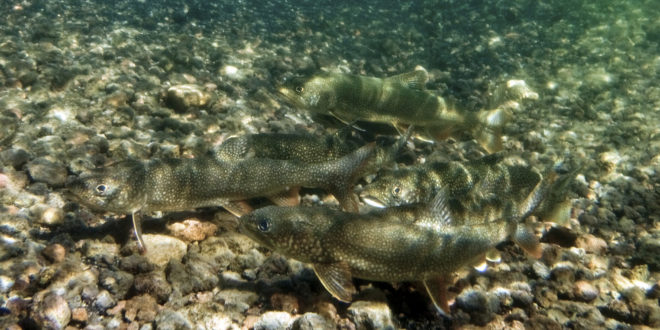As time goes on, anti-lake trout efforts in Yellowstone National Park is becoming more extensive and more efficient.
Since the fish was introduced in the mid-1990s, lake trout has displaced native trout species like the cutthroat, which has ripple effects across the Greater Yellowstone Ecosystem. Crews remove hundreds of thousands of lake trout each year, although they continue to dominate Yellowstone Lake.
That may not be bad news, necessarily, for longtime Yellowstone fishers. Indeed, according to the Powell Tribune, with the opening of Yellowstone’s fishing season Friday, May 26, Yellowstone Superintendent Dan Wenk had brief, encouraging advice for anyone looking to fish lake trout: “Catch them, kill them and eat them.”
Park policy has no weight or size limit on lake trout. Further, lake trout cannot be returned alive once caught, a policy meant to help preserve the smaller cutthroat. From the Tribune:
“They’re a wonderful fish, but they just don’t belong here,” said Phil Doepke, who has been part of the cutthroat trout conservation effort for 14 seasons.
Doepke is part of a team of scientists that has been working hard to remove the unwanted fish from the lake since the species was discovered there in 1994. Netting for lake trout started in 1995, but only in a discovery effort.
Now, the Native Fish Conservation Program team not only works extremely hard to remove the damaging species, but they’re working smart.
Dr. Todd Koel (pronounced Cool) has been leading the team for 17 years. He and his crew have been creating more efficient ways to remove lake trout every season. Currently, they’re surgically implanting transmitters in individual lake trout and releasing them to study their patterns.
The implanted fish, called Judas fish, are making efforts easier.
“The Judas fish lead us to their friends, and then we kill them,” Koel said.
The team recently started using small aircraft to search the lake for the tagged Judas fish. A plane can cover the entire lake, which is approximately 22 miles long, in a couple hours. Travel by boat is far less efficient.
“I’m hopeful we can shift completely to flights to find fish soon,” Koel said.
The team is still using nets; there are 35 to 40 miles of nets in the lake every day, from ice-out in the spring until the lake freezes over again in the fall. But even the netting effort is becoming more efficient, thanks to the big brains on the boats and in the lab. The use of nets occasionally leads to mortality of cutthroats, but the ratio of caught lakers to cutthroats is very high thanks to studies in net size, depth and patterns used as they are deployed.
Doepke and other team members on the boat are extremely competitive.
“I believe I’ve taken out more lake trout than anyone else,” Doepke said. He has served as a boat captain for 14 seasons. Doepke did his master’s thesis on Yellowstone cutthroat trout.
But Dr. Pat Bigelow disputes the claim.
“This is my 20th season,” she said, wearing a fishing cap that looked to have at least two decades of fish gut stains on the bill and staring down Doepke with a competitive smile.
Koel adds that, as his team’s work intensifies, lake trout in Yellowstone Lake may be heading toward population collapse within ten years—give or take. In the meantime, fishery managers say: buy a fishing permit and get out there. Also: Make sure to release any cutthroat trout you catch.
 Yellowstone Insider Your Complete Guide to America's First National Park
Yellowstone Insider Your Complete Guide to America's First National Park





